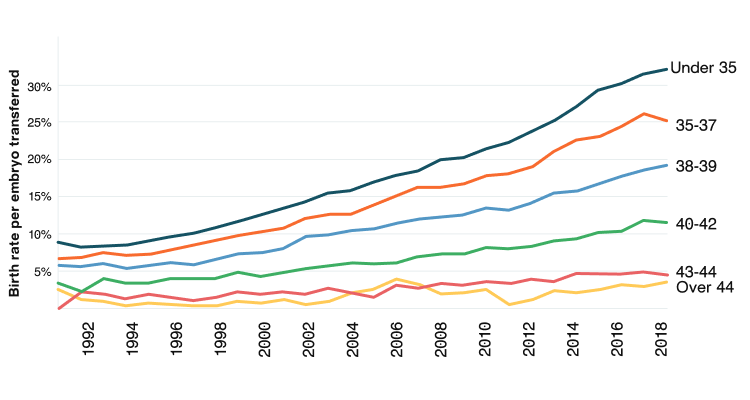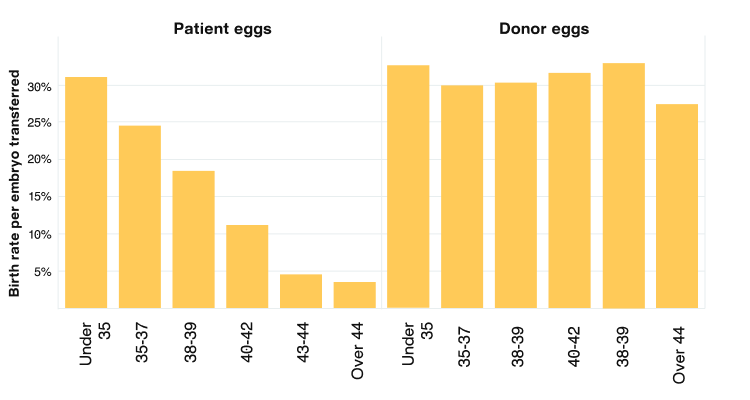A Guide to IVF Success Rates
In vitro fertilization (IVF) has come a long way since its first successful birth in 1978. With more than eight million babies born through IVF, this form of reproductive medicine has allowed many aspiring parents to start the family they’ve always wanted. However, as it can be an expensive treatment to undergo, the initial question that comes to mind for many of these aspiring parents is, understandably, “how successful is IVF?” Determining overall IVF success rates can be tricky, as it’s often dependent on a number of individual factors.
In this article, we’ve aimed to create a detailed guide around IVF success rates. We looked into how successful this form of reproductive medicine is overall, what we mean by this, as well as examining the key factors affecting IVF success.
In Vitro Fertilization: What Is It?
In vitro fertilization (IVF) is a form of reproductive medicine which involves the fertilization of female eggs outside of the body. Instead of the conventional fertilization of the egg in the uterus, IVF allows for fertilization in a laboratory and the embryo is then implanted into the uterus.
IVF is commonly undertaken by heterosexual couples who are unable to conceive naturally. However, the procedure is also popular among male homosexual couples or single women who are looking to become pregnant through a sperm donor. For same-sex female couples, reciprocal IVF is an alternative option. Typically, this procedure involves one partner in the couple providing the egg — which is combined with donor sperm — while the other partner carries the child.
IVF Success Rates: What Do We Mean By This?
It’s important to define exactly what we’re classifying as an “IVF success.” For the purposes of this article, we are going to follow the definition used by Human Fertilisation and Embryology Authority (HFEA). They define success rate as the number of live births per embryo transferred. Therefore, this is what we’ll be using as the benchmark for judging whether or not an IVF is successful.
How Successful Is IVF?
As with all fertility treatments, IVF success rates can be very dependent on external factors. This can make predicting results for the treatment tricky, especially since each couple goes into it with different individual circumstances and backgrounds. However, we’re still able to draw some conclusions and general trends which highlight how successful the procedure is overall.
The main conclusion that can be taken from recent data is that overall IVF success rates have increased. There are also some other key conclusions that we can draw from this 2018 HFEA data.
1. The average birth rate was 23% among all patients under the age of 43. This figure has been consistently increasing year on year since 1991.
2. IVF success rates for patients aged under 35 were 31%.
3. Live birth rates stayed above 20% for the first three IVF cycles.
4. Donor eggs can increase IVF success rates to 25%, however, they were only used by 18% of patients aged under 40.
5. NHS funding for IVF in England fell to less than 30% in parts of England, compared to 60% in Scotland.
However, while the success rates of IVF are moving in a positive direction, there are still a few important factors that can have an effect on this. We’ve looked into these below to understand how they can contribute to the number of successful births through IVF.
What Are the Factors Affecting IVF Success Rates?
When it comes to looking in detail at recent IVF success rates, there are several important factors that should be considered. These include age, how many embryos are transferred, whether or not donor eggs are used, the specific clinic visited, and general health and lifestyle. Below, we’ve examined each of these points in more detail and looked closely at recent, reliable data to understand how they affect overall IVF success rates.
1. IVF Success Rates by Age
The first, and arguably most important, factor affecting IVF success is age. Looking at a wide picture, we can see from HFEA data that overall IVF success rates have been steadily improving among patients below 43 years old over the last three decades. The rate of progression clearly varies among age groups, however, trends are all generally heading in an upwards direction, with some recent dips. Note: The graph below only shows data about IVF carried out using a patient’s own eggs.

Figure 1. IVF success rates per embryo transferred for patients up to 43 years old since 1991
As we can see above, age is a key factor in determining the outcome of an IVF procedure. IVF success rates by age in 2018 were:
31% for women under 35, an increase from 9% in 1991 📈
25% for those aged 35-37, increasing from 7% in 1991 📈
19% for 38-39 year olds, compared to 6% in 1991 📈
11% for women between 40-42, an increase from 3% in 1991 📈
<5% for women aged 43 and over, remaining fairly stable since 1991📊
This variation in success is due to the fact that fertility decreases with age, a trend that is shown clearly in the graph above. However, there has been a general upward trend when it comes to IVF success rates across all age groups in recent years, with the exception of the over 43 year old age group which remained at around 3.5%.
Birth rates grew most consistently among women under 35, increasing from 9% in 1991 to 31% in 2018. Similar, yet not so rapid, increases were also seen in the 35-37, 38-39, and 40-42 age groups. We could, in part, put these increased success rates down to medical advancements and developments since 1991. As well as this, new advancements in the use of donor eggs have also helped to push forward IVF success rates.
2. The Number of Embryos Transferred
The second important factor to consider when looking at IVF success rates is the number of embryos that are transferred. On average, a patient has three cycles of IVF, with one embryo transferred in each. HFEA data shows that in 2018, a live birth occurred in around every one in four embryo transfers. Below, we’ve outlined a graph showing how the chances of a live birth from IVF are affected by the number of embryos transferred.

Figure 2. IVF success rates per cycle using own egg across patient ages
As we can see from the graph above, the average age in which women undergo their first cycle of IVF is 34. During the first cycle, birth rates per embryo transferred were 26%, decreasing to 12% by the tenth cycle. Importantly though, birth rates remained above 20% for the first three cycles, which has certainly been a contributing factor to overall increases in IVF success rates.
This graph also highlights the way in which the number of embryos transferred and patient age have a correlated effect when it comes to IVF success rates. The data shows that the average age of patients who undergo ten cycles of IVF is 39. As previously mentioned, older patients see less positive IVF results as fertility tends to decrease with age. This can then partly explain why the success rates in the tenth IVF cycle are significantly lower than the first.
3. Patient vs. Donor Eggs
HFEA’s study also found that the choice of donor and patient eggs can also have an effect on IVF success rates. As we saw earlier, there was a big difference in birth rates for patients aged 35 compared to those aged 43 and above. However, HFEA’s study found that success rates stayed above 25% for all age groups in cases where donor eggs were used. The graph below highlights this in more detail.

Figure 3. Comparison of IVF success rates using donor and patient eggs across age groups
As we can see, the use of a donor egg can increase the chance of a successful outcome. This is especially true among the older age groups with:
Birth rates for the 40-42 group increasing from 11% to 32%.
An increase from 5% to 33% for women aged 43-44.
Birth rates increasing from 4% to 28% among women over 44.
IVF success rates only increased from 31% to 33% for women under 35 who used donor eggs. This partly highlights why women in the over 44 age category were three times more likely to use donor eggs than those under the age of 40.
4. Additional Factors: Overall Health and Clinic Choice
As well as the important factors discussed above, there are a few additional aspects that can affect IVF success rates. First of all, ensuring that you’re in good health is really important. This means maintaining a healthy, stable weight, reducing stress, avoiding alcohol, and quitting smoking. Smoking in particular, has a negative effect on the quality of both sperm and egg, so cutting this out can significantly improve the chance of seeing a successful outcome.
As well as your health and lifestyle, the specific clinic that you choose for your IVF journey might also play a role in the result. It can be tricky to determine overall quality here, as the IVF success rates of a specific clinic are often dependent on the type of patients that are treated there. For instance, as we saw earlier, birth rates for older patients are typically lower. Therefore, if a clinic has treated more older than younger patients, their IVF success rates will probably be lower, but this doesn’t necessarily mean that they provide a lower quality of care than somewhere with higher success rates.
Clinic choice can play a particularly significant role in the UK, due to what’s known as the "IVF postcode lottery." This refers to the north-south divide in England, whereby the options for IVF treatment vary depending on which part of the country you live in. Not only is treatment often dependent on the part of the country that you live in, but NHS IVF is also becoming increasingly inaccessible for older women. For example, almost half of the clinical commissioning groups (CCGs) in England no longer offer NHS IVF to women who are aged between 40 and 42. Furthermore, over 10% of them refuse access completely to women older than 35.
At Qunomedical, we have done the legwork for you to find high-quality, affordable, and accessible IVF clinics. Having thoroughly vetted a wide range of IVF clinics worldwide, we will only ever provide you with information about those that provide exceptional care, at a fair price. If you’re interested in knowing about the specific IVF success rates of your chosen clinic, then your Qunomedical Patient Manager will be happy to help.
IVF Abroad
As previously mentioned, accessibility to IVF in the UK through the NHS is becoming more and more difficult. As well as this, varying regulations around the age at which you can undergo the treatment and the number of embryos you can have transferred are becoming increasingly restrictive. These are some of the key reasons why travelling to undergo IVF abroad has become an increasingly popular option in recent years. IVF clinics abroad are often a lot more accessible, especially to older women, and offer high-quality treatment at a fair price.
For example, Embryoland is a leading fertility clinic in Greece. Founded in 2008, the team specialises in IVF and egg donation, delivering over 4,000 babies to aspiring parents. IVF clinics abroad are also home to internationally renowned doctors. Dr. Berk Angun, MD for example, is based at the Dunya IVF Clinic in Cyprus. Practising since 1998, Dr. Angun is a leading fertility specialist and has performed over 7,500 treatments during his career.
How to Get Started
At Qunomedical, we are here to help you get your IVF treatment underway. Interested in finding out more about the treatment and how it works? Looking for more detailed information on costs? Contact us and one of our Patient Managers will be in touch. After getting to know you, they will be happy to provide you with all of the help that you need, including assisting you in finding high-quality, affordable IVF treatment options abroad and at home. Whether you decide to book a treatment or not, we offer a 100% free, non-binding assessment. Your Patient Manager will be with you every step of the way, from initial consultations, through to your successful recovery.
Find the Right Specialist at a Fraction of the Cost
Qunomedical only lists clinics and doctors that have been thoroughly vetted with quality and affordability in mind. Contact us for your 100% free, non-binding assessment.
Disclaimer
The information in this article is for educational purposes only and does not replace medical advice. Always consult your doctor before starting any treatments.

Patient manager
Frieda
Your personal Patient Manager
Let's talk
Still unsure? Feeling overwhelmed? Talking to a real person can give you the guidance and reassurance needed. You don’t have to do it alone. Let’s find the right doctor together.
